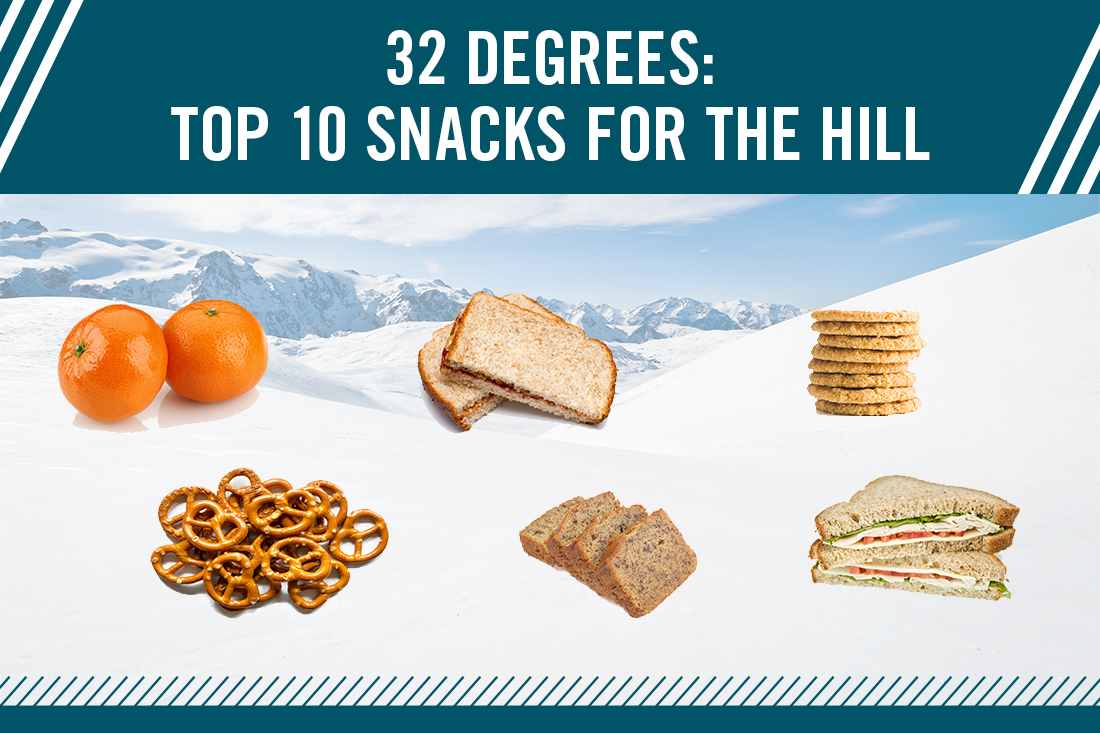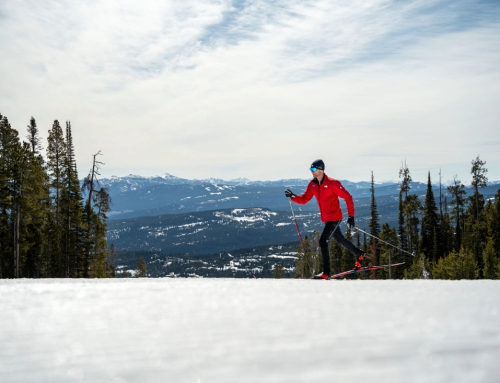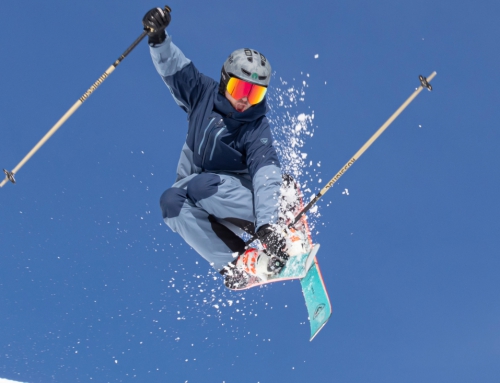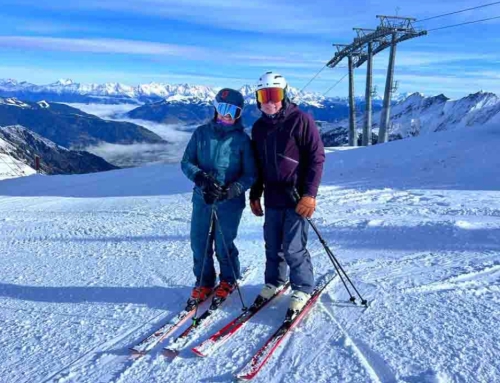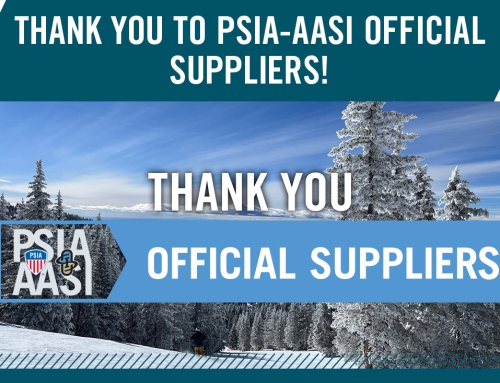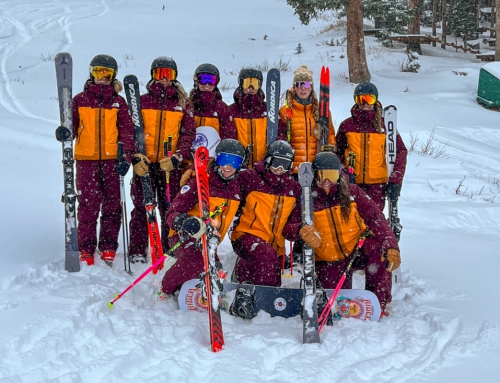32 Degrees: Top 10 Snacks for the Hill
This article by Makayla Meixner appeared in the Winter 2024 Issue of 32 Degrees. You can also listen to a First Chair Podcast interview with Makayla and earn 1 CEU by watching her recorded webinar, “Nutrition Workshop: Fueling for the Mountain.”
To perform your best, you need fuel to sustain your energy. Similar to refueling the gas tank in your car, if you go too long without eating on the hill you’ll eventually be running on fumes. Eating well, and snacking throughout the day, will help you keep your energy levels high so you can perform and help your students excel.
It’s a good idea to keep a snack or two in your pocket to help when you’re in a pinch – in the middle of a lesson, smack dab between meals, or far from a food source. You can use these tips to find and prepare the best snacks to get your body the right nutrients for skiing and riding.
Choosing the Perfect Snack
The perfect pick-me-up is practical to carry with you, and something you can easily digest so it will sit well in your stomach during exercise. Here are a few criteria to consider:
- Rich in carbohydrates. Snacks made from grains, fruit, and sports bars are often the most practical carb sources for the mountain. Other foods, such as starchy vegetables (e.g., potatoes), beans, and certain dairy products also contain carbs, but they are hard to carry with you on the slopes.
- Sits well in your stomach. Foods high in fat and fiber are harder to digest when you’re active. As a rule of thumb, aim for easier-to-digest snacks if you have a sensitive stomach or anticipate your heart rate may be high. For instance, pocket bacon might not be the best thing to eat during an uphill climb because the fat content makes it hard for your body to break the food down and convert it into useable energy.
- Keeps you full and As long as your stomach can handle it, pairing a carb-rich snack with protein, fat, or fiber can help you stay fuller for longer. For example, a trail mix with dried fruit and nuts.
- Easily portable. Portable snacks should hold up well and not be too bulky if you’re keeping them in your pocket. For example, crunchy bars that crumble into dust in your pocket are NOT very portable.
- Freeze factor. Foods with a high-water content or more likely to freeze. Regardless of the pocket snack you choose, it’s always best to keep your snacks in an inside pocket on colder days.
Carbs Will Help You Fuel
Again, if you want sustained energy on the mountain, carbohydrates are key. Carbs are the main fuel source for your brain, red blood cells, and muscles. If you’re sitting down reading this (i.e., at rest), your body is primarily burning fat for energy.
When you’re physically active outside on the slopes you shift from primarily burning fat to relying more heavily on carbohydrates to fuel your working muscles. At a moderate intensity, you burn about 50% fat and 50% carbohydrates. As intensity increases, so does the amount of carbs your body uses. Ultimately, the higher your heart rate, the more your muscles rely on carbs for fuel.
Unlike with fat, which your body can store for later use, your body can only store so many carbs at any given time. This is why munching on carb-rich snacks throughout the day is so important – as your carb tank depletes, you need to refill it so your muscles have the fuel source they need to perform. Otherwise, you’ll slow down or stop altogether. Some people describe this as “hitting a wall,” or “bonking.” So, to keep your energy levels up, focus on including carbs.
Top 10 Pocket Snacks
Here are some of the best snacks to keep you fueled and energized. Pro tip: Keep a stash of these snacks in your car, backpack, or locker.
1. Bars
Bars are a tried-and-true snack.
2. Sports Foods
Sports foods include snacks such as energy chews, gels, and wafers. These are formulated to be carb-rich and easily digestible. These are a great option if you have a low appetite, a sensitive stomach, or need a quick burst of energy.
3. Pretzels
You can stick to plain pretzels or spice it up with flavored varieties for a savory pocket snack. Or try pretzels filled with peanut butter or sunflower seed butter.
4. Fruit
If you’re bringing a backpack, oranges are a great source of energy. More portable fruit options include dried fruit, squeezable applesauce pouches, and fruit leathers.
5. PB&J
This list wouldn’t be complete without a pocket PB&J. Your bread can make a difference here. If you want to stay fuller for longer, opt for 100% whole grain bread.
6. Bagel
Aim for 100% whole grain bagels if you want to stay fuller longer. You can also switch up your spreads. Try peanut butter and fruit-flavored cream cheeses if you prefer sweeter snacks or regular and veggie cream cheeses if you prefer savory flavors.
7. Turkey Sandwich
This doesn’t have to be turkey, you can use deli meat, or tofu or tempeh for a plant-based option. The protein in your sandwich will help keep you full and satisfied. If you don’t like squished bread, pack sandwiches only on those days you’re bringing a backpack.
8. Banana Bread
Banana bread is delicious and satisfying. Get creative and mix-in chocolate chips, blueberries, craisins, or nuts.
9. Oatmeal Cookies
From a nutrition standpoint, oatmeal cookies are similar to many packaged granola bars. If you have the time, save your money and make cookies for yourself.
10. Protein Waffle
Pick up a boxed protein waffle mix or whip up your own. Waffles are great because you can eat them plain, get creative with mix-ins, or even make PB&Js out of them. You will need a waffle-maker, but not a bad investment if you want tasty pocket snacks all season long.
Feeling snacky? It’s time to stock up on your favorite pocket snacks to keep you fueled for long, and fun, days on the hill.
Makayla Meixner is an AASI-certified Level I snowboard instructor based out of Breckenridge, Colorado. She holds a master’s in nutrition and is a registered sports dietitian who works primarily with winter sport athletes through her online private practice, Own It Nutrition.

